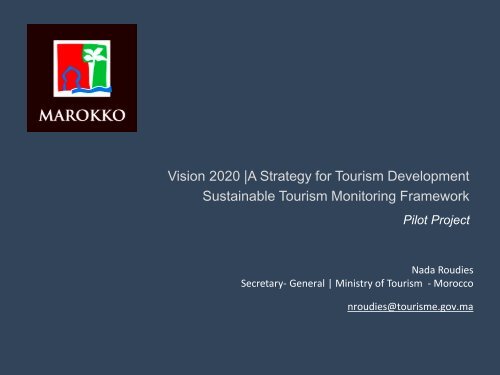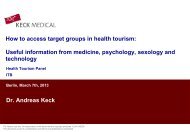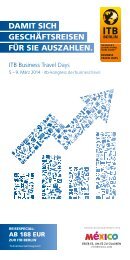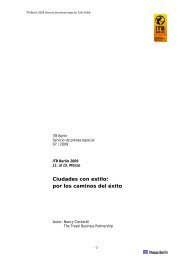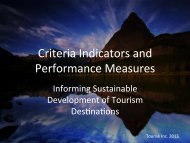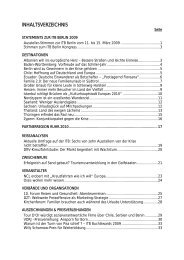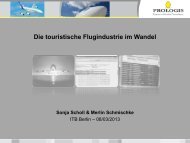Advancing Sustainable Tourism: Nada Roudies (PDF, 586.7 kB)
Advancing Sustainable Tourism: Nada Roudies (PDF, 586.7 kB)
Advancing Sustainable Tourism: Nada Roudies (PDF, 586.7 kB)
You also want an ePaper? Increase the reach of your titles
YUMPU automatically turns print PDFs into web optimized ePapers that Google loves.
Vision 2020 |A Strategy for <strong>Tourism</strong> Development<br />
<strong>Sustainable</strong> <strong>Tourism</strong> Monitoring Framework<br />
Pilot Project<br />
<strong>Nada</strong> <strong>Roudies</strong><br />
Secretary- General | Ministry of <strong>Tourism</strong> - Morocco<br />
nroudies@tourisme.gov.ma
Summary<br />
I- Global <strong>Tourism</strong> background in Morocco<br />
II- ‘Vision 2020’: Ambitions, Solid foundations, and strategic dispositions<br />
III- Focus on Sustainability, a challenge that needs to be taken up<br />
a. Approach adopted<br />
b. Formalizing the scoreboard for monitoring sustainable tourism indicators<br />
Morocco <strong>Tourism</strong> Indicators<br />
2
<strong>Tourism</strong>: A national priority in Morocco<br />
Vision 2010<br />
• Moroccan tourism’s<br />
international achievement:<br />
ranked 25 th worldwide by the<br />
end of 2010<br />
Tourists arrivals at borders (millions)<br />
• In the Moroccan economy:<br />
<strong>Tourism</strong> is among the top<br />
foreign exchange earners, the<br />
2 nd biggest contributor to GDP,<br />
and the 2 nd biggest job creator<br />
Vision 2020<br />
To raise Morocco, by 2020, to become one of the world’s top 20 tourist destinations<br />
and a model of sustainability in the mediteranean destinations<br />
OBJECTIVES IN FIGURES<br />
Doubling the size of the sector<br />
• 200 000 new beds<br />
• Double touristic arrivals<br />
• Triple domestic trips<br />
2 nd economic sector :<br />
• 470 000 new direct jobs<br />
• Double touristic receipts to reach 140 billon DHs<br />
• 2 additional points to the touristic GDP
II- The strategy ‘Vision 2020’: Ambitions, solid foundations, strategic dispositions<br />
a) A territory-based tourism policy of all the regions of Morocco:<br />
Introducing the 8 tourist territories (destinations)<br />
b) A new institutional framework for a dynamic regulation<br />
To ensure the implementation of the 2020 Vision and strengthen<br />
the institutional legitimacy<br />
of an industry as multi-functional as tourism, a national steering<br />
instance, involving<br />
the state, regions and the private sector in a renewed partnership,<br />
will be defined:<br />
«The High Authority for <strong>Tourism</strong>.»<br />
Developing 8 touristic territorial agencies to be in charge of the<br />
development of tourism at the local level<br />
c) An integrated approach of tourism sustainability<br />
To promote a specifically Moroccan model of sustainable<br />
tourism, 3 challenges must be met:<br />
> 6 STRUCTURING PROGRAMS for a diversified portfolio of<br />
products, are build around culture, seaside and nature, with<br />
sustainability in the background and supplemented with programs<br />
centered on certain high added value niches.<br />
Azur 2020; Green / <strong>Sustainable</strong> Development; Culture &Heritage;<br />
Entertainment, Sports &Leisure; Business, Health&Wellness; Domestic<br />
<strong>Tourism</strong> - Biladi<br />
Morocco <strong>Tourism</strong> Indicators<br />
1- Optimization of the natural/environmental resources<br />
2- Respect the authenticity and the identity of the local<br />
populations<br />
3- Making a fair distribution of the revenus of tourism in the whole<br />
country<br />
4
III - Focus on Sustainability, a challenge that needs to be taken up.<br />
An integrated program of sustainable tourism development<br />
To implement the ambition of sustainability which is at the heart of the strategy, an integrated<br />
scheme will be developed to cover the different dimensions of tourism development:<br />
management, monitoring, developing and implementing regulations.<br />
Morocco <strong>Tourism</strong> Indicators<br />
5
III - Focus on Sustainability, a challenge that needs to be taken up.<br />
An integrated program of sustainable tourism development<br />
Marketing &<br />
Promotion<br />
SUSTAINABILITY<br />
MONITORING MECHANISM<br />
To develop and collect a specific set of<br />
indicators of sustainability performances<br />
to measure the impact of the industry on the<br />
environment (on the national level and<br />
concerning the most vulnerable sites).<br />
REINFORCEMENT OF<br />
THE ENVIRONMENTAL<br />
REGULATIONS<br />
INCENTIVES<br />
TRAINING AND<br />
RAISING AWARENESS<br />
PROGRAMME<br />
Morocco <strong>Tourism</strong> Indicators<br />
6
III - Indicators of sustainability in <strong>Tourism</strong><br />
Sustainability monitoring device: Integrated mechanism for the collection and production of indicators for monitoring<br />
sustainability at multiple scales (national, regional and unitary).<br />
Targets :<br />
STEERAGE and ANALYTICAL MONITORING of SUSTAINABILITY<br />
COMMUNICATION<br />
Allow the management of tourism sustainability<br />
to implement the strategy of sustainable tourism, the Ministry and<br />
the tourism industry need :<br />
- An effective vision of dimensions that should be given top<br />
priority;<br />
-to measure the impact of the implemented actions;<br />
- Objective assessment of sustainability at each tourism<br />
destination.<br />
Ensure the visibility of sustainable tourism<br />
strategy and position Morocco as a major tourism<br />
destination, highly differentiated within the<br />
Mediterranean basin, by approaching international<br />
prescribers and targeting segments / markets that<br />
are sensitive to the issues of sustainability.<br />
Morocco <strong>Tourism</strong> Indicators<br />
7
III - Indicators of sustainability in <strong>Tourism</strong><br />
METHODOLOGICAL APPROACH<br />
a<br />
Identify sustainability criteria<br />
EnvironmentalPillar<br />
b<br />
Define the objectives of the<br />
monitoring device<br />
c<br />
DEFINING THE<br />
STRUCTURING<br />
DIMENSIONS OF<br />
SUSTAINABILITY<br />
ANALYSING THE LIFE CYCLE<br />
PRODUCT<br />
TOURISTIC EXPERIENCE<br />
Socio EconomicPillar<br />
social/cultural pillar<br />
c<br />
SUMMARY OF THE SRUCTURING DIMENSIONS OF SUSTAINABILITY<br />
<strong>Tourism</strong> pressures on the<br />
natural resources<br />
Efficiency in the use of the<br />
water and energy<br />
<strong>Tourism</strong> pressures on the<br />
host communities<br />
Participation of tourism in<br />
promoting tangible and<br />
intangible heritage and<br />
natural resources<br />
Engagement of the<br />
stakeholders in sustainable<br />
approachs/ social<br />
responsability<br />
<strong>Tourism</strong> contribution to the<br />
local economy and<br />
employment development<br />
Authenticity of the tourism<br />
experience and tourist<br />
satisfaction<br />
d<br />
DEFINITION AND SELECTION OF THE INDICATORS<br />
The degree of relevance of<br />
monitoring indicators have<br />
been tested from different<br />
dimensions<br />
FEASIBILITY<br />
• Availability of information<br />
• Ease of implementation(time and<br />
resources needed, construction,<br />
mobilization)<br />
IMPACT<br />
• Comparability<br />
• Clarity and importance of the<br />
perception among stakeholders (tourists,<br />
public, etc ...)<br />
8
III - Indicators of sustainability in <strong>Tourism</strong><br />
SUSTAINABILITY STRUCTURING DIMENSIONS 1/2<br />
Pressure on natural areas (sites)<br />
Pressure on ressources<br />
Exposure to climate risks (floods)<br />
Take into consideration alternative resources when designing<br />
and constructing assests<br />
Creation of green spaces<br />
Pressures on the local population (nuisance, tourist density,<br />
etc.)<br />
Local population access to the equipments/ infrastructure and<br />
tourist attractions<br />
Integration of buildings in the urban local style<br />
Nuisances resulting from constructions<br />
Stability and quality of tourism jobs<br />
Efficiency of resource consumption<br />
Level of use of alternative resources<br />
Efficiency in the management of releases and wastes<br />
Environmentally responsible programs<br />
<strong>Tourism</strong>'s contribution to the promotion and preservation of<br />
natural assets<br />
Seasonal trends of tourism<br />
Use of local compagnies in the design and the construction of<br />
the product<br />
Contribution of tourism to the renovation of cultural monuments<br />
Contribution of tourism to the valuation of intangible heritage<br />
(local culture, gastronomy, etc.)<br />
Participation of tourism in the development of the local economy<br />
and job creation in the region<br />
Employing local people in the construction of tourism assets<br />
Existence of sustainable development offers (labels,<br />
specializedtravelagencies, etc.)<br />
Promotion of Morocco as a green destination to institutional and<br />
private sector (TO, etc.)<br />
EnvironmentalPillar<br />
Socio EconomicPillar<br />
social/cultural pillar
III - Indicators of sustainability in <strong>Tourism</strong><br />
SUSTAINABILITY STRUCTURING DIMENSIONS(2/2)<br />
Existence of UNESCO World Heritage sites (material and<br />
immaterial)<br />
Existence of local initiatives for the environment protection and the<br />
heritage preservation<br />
Existence of sustainable development offer (labels, specialized<br />
travel agencies, etc.)<br />
<strong>Tourism</strong>'s contribution to the promotion of Morocco as a green<br />
destination<br />
Capacity and quality of infrastructure (transit time at the airport,<br />
etc.)<br />
Promotion of environmentally friendly modes of transport<br />
Respect of standards and regulations related to transport<br />
Civil participation of tourism facilities<br />
Staff quality of tourism facilities<br />
Adherence to international standards related to accommodation<br />
The quality of service in the hole touristic chain (in welcoming)<br />
cleanliness and respect of hygiene standards<br />
Concentration/density of tourism<br />
Quality of the interaction with the local community<br />
Level of pollution and nuisances found<br />
Cleanliness and respect of food standards<br />
Qulaity of the interaction with local population<br />
Enhancement of the local gastronomy and local products<br />
Availability of information on the state of sustainability programs<br />
implemented<br />
condition of natural and cultural sites (quality of bathing water,<br />
Pollution, etc.)<br />
Tourist experience
Reporting<br />
Copilsecretary<br />
Production of regional SDI<br />
Reporting et field reports<br />
III - Indicators of sustainability in <strong>Tourism</strong><br />
Governance of the sustainability monitoring framework<br />
Steering Committee<br />
(Ministry of <strong>Tourism</strong> – Ministry of Environment)<br />
Monitoring suistanability within tourism and V2020 orientations in<br />
the light of sustainability report<br />
Monitoring Committee<br />
(<strong>Tourism</strong> – Environment)<br />
• Follow up, consolidation and reporting to the<br />
steeringcommittee<br />
• Risk Management<br />
• Draw up institutional communication plans<br />
• Prepare sustainability status report<br />
• Production of tourism sustainability scoreboard<br />
• Recommandations &<br />
orientations<br />
•Selecting dimensions of<br />
sustainability to follow<br />
•Take a decision regarding<br />
the indicators list<br />
•Decide annually on the<br />
progressive geographical<br />
expansion of the device<br />
•Validate the<br />
communication plan of the<br />
indicators<br />
Regional monitoring committee of sustainability<br />
(local representatives of <strong>Tourism</strong> – Environment) within the regional<br />
observatory of environment<br />
• Collecting et centralizing the<br />
indicators at the regional<br />
level<br />
PHASES OF IMPLEMENTATION<br />
2013 2014 2015<br />
Starting with a pilot destination-<br />
Marrakech<br />
Evaluation of the pilot<br />
+ Starting the expansion of the<br />
monitoring tool to other destinations<br />
Genralisation of the<br />
process and taking it to a<br />
national level


